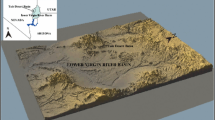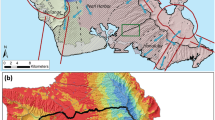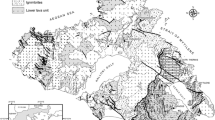Abstract
Zones of mixing between shallow groundwaters of different composition were unravelled by “two-way regionalized classification,” a technique based on correspondence analysis (CA), cluster analysis (ClA) and discriminant analysis (DA), aided by gridding, map-overlay and contouring tools. The shallow groundwaters are from a granitoid plutonite in the Fundão region (central Portugal). Correspondence analysis detected three natural clusters in the working dataset: 1, weathering; 2, domestic effluents; 3, fertilizers. Cluster analysis set an alternative distribution of the samples by the three clusters. Group memberships obtained by correspondence analysis and by cluster analysis were optimized by discriminant analysis, gridded over the entire Fundão region, and converted into “two-way regionalized classification” memberships as follows: codes 1, 2 or 3 were used when classification by correspondence analysis and cluster analysis produced the same results; code 0 when the grid node was first assigned to cluster 1 and then to cluster 2 or vice versa (mixing between weathering and effluents); code 4 in the other cases (mixing between agriculture and the other influences). Code-3 areas were systematically surrounded by code-4 areas, an observation attributed to hydrodynamic dispersion. Accordingly, the extent of code-4 areas in two orthogonal directions was assumed proportional to the longitudinal and transverse dispersivities of local soils. The results (0.7–16.8 and 0.4–4.3 m, respectively) are acceptable at the macroscopic scale. The ratios between longitudinal and transverse dispersivities (1.2–11.1) are also in agreement with results obtained by other studies.
Similar content being viewed by others
References
Costa, C. V., Pereira, L. G., Portugal Ferreira, M., and Santos Oliveira, J. M., 1971, Distribuição de oligoelementes nas rochas e solos da região do Fundão: Memórias e Notícias (Publicações do Museu e Laboratório Mineralógico e Geológico da Universidade de Coimbra), v. 71, p. 1–37.
Custodio, E., and Llamas, M. R., 1983, Hidrología subterránea: Ediciones Omega, Barcelona, Spain, Vol. 1, 1157 p.
Domenico, P. A., and Schwartz, F. W., 1990, Physical and chemical hydrogeology: Wiley, New York, 824 p.
Harff, J., and Davis, J. C., 1990, Regionalization in geology by multivariate classification: Math. Geol., v. 22, no. 5, p. 577–588.
Jackson, J. E., 1991, A user’s guide to principal components: Wiley, New York, 569 p.
Jobson, J. D., 1992, Applied multivariate data analysis, Vol. 1. Regression and experimental design: Springer-Verlag, New York, 621 p.
Kaufman, L., and Rousseeuw, P. J., 1990, Finding groups in data: Wiley, New York, 342 p.
Krumbein, W. C., and Monk, G. D., 1943, Permeability as a function of the size parameters of unconsolidated sand: Trans. Am. Inst. Min. Met. Eng., v. 151, p. 153–163.
Olea, R. A., 1999, Geostatistics for engineers and earth scientists: Kluwer Academic Publishers, chapter 14.
Pacheco, F. A. L., 1998a, Finding the number of natural clusters in groundwater data sets using the concept of equivalence class: Comp. Geosci., v. 24, no. 1, p. 7–15.
Pacheco, F. A. L., 1998b, Application of correspondence analysis in the assessment of groundwater chemistry: Math. Geol., v. 30, no. 2, p. 129–161.
Pacheco, F. A. L., and Van der Weijden, C. H., 1996, Contributions of water–rock interactions to the composition of groundwater in areas with sizeable anthropogenic input: A case study of the waters of the Fundão area, central Portugal: Water Resour. Res., v. 32, no. 12, p. 3553–3570.
Pacheco, F. A. L., Sousa Oliveira, A., Van der Weijden, A. J., and Van der Weijden, C. H., 1999, Weathering, biomass production and groundwater chemistry in an area of dominant anthropogenic influence, the Chaves-Vila pouca de Aguiar region, north of Portugal: Water, Air Soil Pollut., v. 115, no. 1/4, p. 481–512.
Pfannkuch, H. O., 1962, Contribution à l’étude des deplacement des fluides miscible das un milieu poreux: Rev. Inst. Fr. Petrol., v. 18, no. 2, p. 215–270.
Van der Weijden, C. H., Oosterom, M. G., Bril, J., Walen, C. G., Vriend, S. P., and Zuurdeeg, B. W., 1983, Geochemical controls of transport and deposition of uranium from solution. Case study: Fundão, Portugal: Technical Report, EC contract 007.79.3 EXU NL, Department of Geochemistry, Institute of Earth Sciences, Utrecht University, 67 p.
Ward, J. H., 1963, Hierarchical grouping to optimize an objective function: J. Am. Stat. Assoc., v. 58, p. 238–244.
Author information
Authors and Affiliations
Corresponding author
Rights and permissions
About this article
Cite this article
Pacheco, F.A.L., Landim, P.M.B. Two-Way Regionalized Classification of Multivariate Datasets and its Application to the Assessment of Hydrodynamic Dispersion. Math Geol 37, 393–417 (2005). https://doi.org/10.1007/s11004-005-5955-1
Received:
Accepted:
Issue Date:
DOI: https://doi.org/10.1007/s11004-005-5955-1




